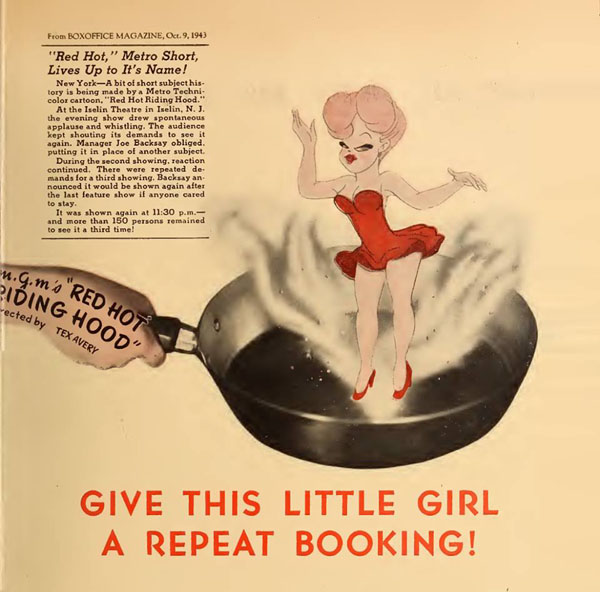
Imagine being in a theater in May of 1943. The lights dim, the curtain rises, and the “MGM Cartoon” logo comes on the screen.
Audiences expecting the innocent chase violence of Tom and Jerry instead find themselves watching Red Hot Riding Hood, a re-telling of the classic “Little Red Riding Hood” fable, filtered through off-the-wall animated sight gags, screwball comedy, and a heavy dose of sex appeal.
In his book, Enchanted Drawings: The History of Animation, author Charles Solomon wrote about the impact this now iconic short subject had on moviegoers and the movie industry:
“Red Hot Riding Hood raised eyebrows and brought down the house. Audiences – especially GIs – loved the film. Censors at the Hays office and/or studio deleted some of the Wolf’s takes from the release prints of the film, although servicemen were allowed to see the uncut version. MGM reported that Red Hot Riding Hood and later “Red” films were the most popular shorts the studio ever released.”
Red Hot Riding Hood came to theaters on May 8, 1943, and it’s hard to believe that it celebrates its 80th anniversary this year. The cartoon short begins as a very traditional re-telling of “Little Red Riding Hood,” until the three main characters (Red, Grandma, and the Wolf) break the fourth wall and talk directly to the camera, stating that they don’t want to see just another tired re-telling.
The narrator acquiesces and points the tale in a newer direction as the cartoon switches gears. We are taken to Hollywood, where the Wolf is now a tuxedo-wearing playboy who drives around town in a ridiculously long convertible, and Grandma lives in a penthouse, drinking martinis (a neon sign above her building reads: “Grandma’s Joint. Come Up and See Me Sometime”).
The Wolf enters a nightclub where “Red Hot Riding Hood” performs. She first appears in the traditional cloak of Riding Hood as she carries a basket, which she flings off to reveal a skimpy showgirl outfit, as she belts out a song.
The character of Red in this sequence is one of animation’s greatest tour-de-forces by a true master of the medium, as noted by author John Canemaker in his book Tex Avery: The MGM Years, 1942-1955:
“The animation of Red has a marvelous verve and sensuality thanks to Preston Blair, a great character animator formerly known of Disney, where in Fantasia (1940) he made Mickey Mouse tread water and crocodiles and hippos tripped the light fantastic. Red’s design is borrowed from caricatures of ‘innocently sexy’ females drawn by Fred Moore, a Disney animator. ‘Freddie Moore girls’ were simple, animatable designs constructed of sensual pear shapes, and the type found its way into Disney’s 1940s films, starting with Fantasia’s ‘centaurettes.’”
The Wolf’s licentious responses to this – gigantic bug-eyes, jaw drops, freezing vertically in mid-air – brilliantly animated by Ed Love, became a blueprint for cartoon reactions going forward.
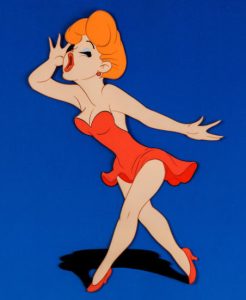 The Wolf attempts to seduce Red, but she wants nothing to do with him and flees to “Grandma’s joint.” The Wolf follows, and when he gets to Grandma’s, she becomes obsessed with the Wolf.
The Wolf attempts to seduce Red, but she wants nothing to do with him and flees to “Grandma’s joint.” The Wolf follows, and when he gets to Grandma’s, she becomes obsessed with the Wolf.
The Wolf attempts to escape, as a series of beautiful sight-gags follow (including one where the Wolf opens a door and slams into a brick wall, upon which a sign reads: “Imagine that! No door!”)
The Wolf eventually jumps out the window and makes his way (bandaged and beaten) back to the nightclub, where he swears off women, stating that he would kill himself before looking at another woman.
Red then comes on stage, and the Wolf pulls out two guns, kills himself, and his ghost proceeds to whistle and clap for Red as the cartoon ends.
Audiences at the time loved Red Hot Riding Hood so much that several follow-ups were made. These included Swing Shift Cinderella, The Shooting of Dan McGoo and Wild and Woolfy (all 1945), as well as Uncle Tom’s Cabana (1947) and Little Rural Riding Hood (1949).
Not everyone applauded the cartoon short. According to author Michael Barrier, in his book Hollywood Cartoons: American Animation in its Golden Age: “Red Hot Riding Hood ran into such serious objections from the Production Code Administration that parts of it had to be remade.”
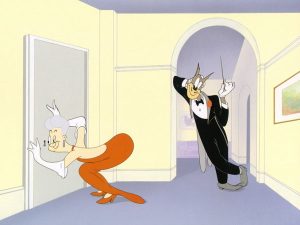 This included the film’s original ending, where the Wolf and Grandma marry and have children.
This included the film’s original ending, where the Wolf and Grandma marry and have children.
The film is one of the shining examples of director Tex Avery’s genius. In the introduction to John Canemaker’s book on the artist, Chuck Jones wrote: “Avery was lightning. Just as unpredictable, as surprising, as spectacular as lightning – with one difference: Unlike lightning, Avery was funny.”
Like all of Avery’s films, Red Hot Riding Hood demonstrates why he is considered the architect of the screwball cartoon. The irreverent humor and comedic creativity that was Avery’s trademark has rightly cemented him as one the kings of cartoons’ golden age and one of the masters of the medium.
With Red Hot Riding Hood, Avery left a legacy for decades after, with its fingerprints seen in a number of films, most notably, 1988’s Who Framed Roger Rabbit and 1994’s The Mask.
The short rightly earned its place at number seven in Jerry Beck’s 1994 book, The 50 Greatest Cartoons As Selected by 1,000 Animation Professionals.
In that book, author Joe Adamson’s words explain why this film continues to be celebrated eighty years later: “…Red Hot Riding Hood keeps reminding us that, as long as we think sex is something we’re able to be adult about, it’s got another joke up its sleeve – and it’s probably on us.”


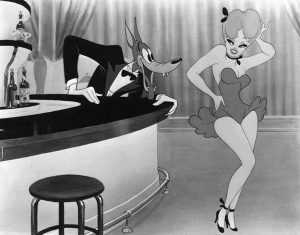
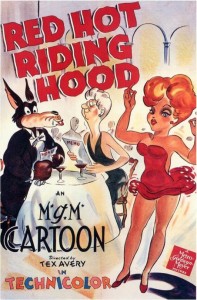
 Michael Lyons is a freelance writer, specializing in film, television, and pop culture. He is the author of the book, Drawn to Greatness: Disney’s Animation Renaissance, which chronicles the amazing growth at the Disney animation studio in the 1990s. In addition to Animation Scoop and Cartoon Research, he has contributed to Remind Magazine, Cinefantastique, Animation World Network and Disney Magazine. He also writes a blog, Screen Saver: A Retro Review of TV Shows and Movies of Yesteryear and his interviews with a number of animation legends have been featured in several volumes of the books, Walt’s People. You can visit Michael’s web site Words From Lyons at:
Michael Lyons is a freelance writer, specializing in film, television, and pop culture. He is the author of the book, Drawn to Greatness: Disney’s Animation Renaissance, which chronicles the amazing growth at the Disney animation studio in the 1990s. In addition to Animation Scoop and Cartoon Research, he has contributed to Remind Magazine, Cinefantastique, Animation World Network and Disney Magazine. He also writes a blog, Screen Saver: A Retro Review of TV Shows and Movies of Yesteryear and his interviews with a number of animation legends have been featured in several volumes of the books, Walt’s People. You can visit Michael’s web site Words From Lyons at: 






















Oh yes, red started something! Oddly enough, I don’t remember seeing “red hot riding hood“ on television. However, I did see other “read“ films on our local ABC affiliate.Tex Avery certainly did start some thing with his “read“ series. In fact Avery change the face of MGM with all his cartoons! I remember seeing most of them on morning TV, before heading to school.
I notice that “Red Hot Riding Hood” premiered on Bob Clampett’s 30th birthday. Bob probably had other plans for the day, but I’m sure he must have enjoyed his former colleague’s tour de force whenever he got around to seeing it.
I can’t help but wonder how many of the servicemen who hooted and whistled at Red in 1943 were, by the time my generation came along, loudly complaining that girls were wearing their skirts too short.
I’ve found too many “premiere” dates are not much more than suggestions, and cartoons appeared in theatres even a week before the official release date.
That said, does anyone know where Red was screened on May 8, 1943? I’ve found it at the Columbia in Paducah, Ky. on May 11 (the feature was “The Human Comedy” with Mickey Rooney and Frank Morgan), but no earlier, at least going by newspaper theatre ads.
Welcome to my world.
Release dates – official or not – are essentially a “rough idea” of when the cartoon would be available at the local film depots for distribution to theaters who booked those series. Many times (though not all) the copyright date more accurately reflects the first public showing of the cartoon. Studios had (and reported) established “release dates” for shorts – to give its exhibitors, and would have them posted in the trades – but historians will note that often the published release date would change in later issues of the trades, based on the reality of when the cartoon was actually eventually booked.
The release dates we published in OF MICE AND MAGIC came from different sources. We had studio release charts for MGM, Columbia and Disney. Many studios, like Paramount and Terrytoons, were taken from trade magazines, and checked with the copyright books. Even so, we’ve found instances (thanks to you Yowp, and others) of some cartoon shorts playing a month earlier here and there. After all these years, I’ve simply decided to stick with Of Mice and Magic dates – because they are either accurate, or pretty darned close.
Quite of an achievement for an animated short.
I recall hearing a story that the cartoon was such a success in during one theater screening that the audience demanded the short be shown again causing a change in the night’s planned line-up.
Maybe at the top of the page?
To be honest, I didn’t read that publicity blurb above the article until now.
Supposedly there were prints of the original version (which included the ending where Wolfie and Grandma end up marrying, to a justice of the peace who resembled Avery!) shipped out overseas for military audiences, so it’s possible, but not likely by this time, that a print of the uncut short still exists somewhere…
That’s interesting. Yes, if that’s the case there’s a slim, but fair chance it could still exist. I know from Disney collectors that a couple of surviving 16mm prints of Disney cartoons with rare original titles were likely originally distributed to the military for entertainment purposes during WWII.
It would certainly be worth checking film archive prints as it may be known that they have a print of this cartoon, but might NOT realise if they have an alternative version. There’s several 35mm of Red Hot Riding Hood held by the British Film Intstitute, for example… Have any serious animation researchers checked these prints?
This is the film that propelled Tex Avery to legendary status.
Red is one of several vintage MGM characters cropping up in the Tom and Jerry direct to videos. In “Tom and Jerry Meet Sherlock Holmes” she’s cast as the detective’s client, a music hall singer blackmailed on the eve of her wedding to a nobleman. In the end the wedding takes place, and we see her beloved is the Wolf. Take that, Production Code.
MGM Cartoon producer Fred Quimby told Tex Avery his Warner Brothers’ rowdyism was not welcome in MGM cartoons. Realizing it would not be cool to quit Avery set out to get fired. He revolutionized animation. We don’t get many like him but that whole crew at Warner Brothers was cut from the same cloth.
I like this cartoon (it’s hard NOT to), but I think it’s just a touch overrated, since it ALWAYS appears on peoples’ “best Avery cartoons” lists. There are quite a few Tex Avery MGM shorts that are just as funny that don’t get talked about as much, like Who Killed Who?, The Hick Chick and Cock-a-Doodle Dog.
Are you talking about “Best Avery cartoons list” or “Funniest Avery cartoons” list?
There is a major difference.
My favorite MGM Avery is “The Peachy Cobbler” – certainly not the funniest, but to me the overall best.
May it forever elude the axe of cancel culture.
That’s an odd comment. Red basically subjects the wolf to the same treatment that she received from him by setting him up with her man hungry grandma. As a women, I find it hilarious and gratifying to see the wolf get his just desserts. I love much of Avery’s work and find his use of physical humor and jabs at social norms to be highly entertaining.
If you’re referring to a certain cartoon skunk being ‘canceled’ you can still buy physical media featuring Pepe or easily search for the older shorts online. It’s understandable that WB/HBO doesn’t want to stream them on a children’s app or have them appear often on family cable. Although Pepe is a parody character his behavior is rather lustful, and he hardly ever gets punished for the same behavior that the villainous wolf gets called out for.
I love Chuck Jones but the Pepe character is rather dated and his shorts tend to all be pretty similar / repetitive on top of it. (I’d rather watch What’s Opera Doc or Duck Amuck. They are the opposite of repetitive or boring. Avery knew when to stop with only about half a dozen Wolf and Red shorts.) Plus, the general public is far more likely to know about a Looney Tunes character than they are to know about Avery’s MGM work. So yeah, Red Hot isn’t going to get ‘canceled’ anytime soon.
He’s still on METV.
That’s a good compromise since those who enjoy old Looney Tunes often watch other classic media as well. Everyone wins. Admittedly, I enjoy a quite a few older movies which contain scenes that would never pass muster today (such as Mickey Rooney in Breakfast at Tiffany’s. Ooff.) Such scenes don’t completely discredit an older work if the rest of film is great. When watching with my kids however, I make sure to make it a teaching moment and talk about how things have changed. Hindsight is everything.
I’m just tired of politicians trying to make nothing burgers out of pop culture ‘controversies’ when there really isn’t a controversy half the time to begin with. Buzz words used to whip people into frenzy such as ‘cancel culture’ or ‘woke’ have pretty much lost meaning at this point.
Agreed, Hans.
Is there any actual/tangible proof that the short had additional scenes/different ending that were edited out save for prints made for viewing by military personnel/servicemen? Any storyboard/script/cel/photographic evidence anywhere that additional scenes were actually produced/filmed/printed/distributed to the military out there?
I can’t speak to any actual film footage, but there is a publicity cel set-up (similar to the one included at the top of this post) that depicts Grandma and the Wolf (looking worse for wear) at the Justice of the Peace (a caricature of Avery). Additionally, there’s a publicity picture of Avery himself where production materials from the short are visible behind him, including the full background from the aforementioned scene, which includes the howitzer Grandma used to keep the Wolf in line!
It seems to me the original ending was either discarded very late in production, or filmed and cut after previews.
Let’s see…. A beautiful singer in a sexy red dress is pursued by an unwelcome suitor who tries to tempt her with his stockpile of rationed items. She emphatically hollers “NO!”, and in the end the suitor winds up affianced to her mother. Sounds like… the 1944 Terrytoon “Carmen’s Veranda”. Of course there are plenty of differences between it and “Red Hot Riding Hood”: the setting is an opera house instead of a nightclub, Gandy Goose rides a flying Pegasus to the rescue, and the beautiful girl is a white pussycat (who would later return as “Gandy’s Dream Girl”). It wouldn’t have occurred to me that the two cartoons had anything in common if I hadn’t just seen them back-to-back. But given the sensation created by Red in 1943, I have to wonder….
Funny one, but superseded by the sequels. Oddly, I thought she was at her hottest here, all bouncy.
I would love to see that cut ending where the Wolf has children, I can just imagine how the kids must have been drawn.
Supposedly, Clark Gable stopped in at the animation studio to find out who the real life model for Red was and how to contact her, and the artists had to break his heart by telling him that she was just a character they had dreamt up.